Abstract
Jones, Galen E. (Scripps Institution of Oceanography, University of California, La Jolla). Effect of chelating agents on the growth of Escherichia coli in seawater. J. Bacteriol. 87:483–499. 1964.—Escherichia coli did not grow at 37 C, or grew only after a prolonged lag phase in filter-sterilized basal seawater medium (synthetic or natural seawater supplemented with glucose, NH4Cl, and K2HPO4). When this basal medium was enriched with 0.01% or less organic matter, such as casein hydrolysate, peptone, or yeast extract, growth always occurred after a short lag phase. Adding 10−5m cysteine or autoclaving the seawater gave a similar effect. A variety of organic chelating agents (histidine, glycine, methionine, glycylglycine, 8-hydroxyquinoline, thioglycolic acid, o-phenanthroline, disodium ethylenediaminetetraacetic acid, etc.) reversed the toxicity of filter-sterilized basal seawater medium in concentrations predictable from stability constants. Even metal-complexing agents such as Na2S2O3, Na2S, and NaCN in appropriate concentrations reversed toxicity. The quality of the distilled water and the treatment of glassware had a significant effect on the growth of E. coli in basal seawater medium. It was concluded that iodate is probably not the toxic substance for E. coli in seawater, since relatively high concentrations were stimulatory. The inhibition resulting from the individual salts of synthetic seawater was proportional to their concentration; NaCl was most inhibitory. This toxicity is believed to be derived from trace impurities in the reagent-grade chemicals used to prepare synthetic seawater. Evidence was also found for the toxicity of heavy metals in natural seawater. Heavy metals in seawater appear to inhibit growth but not respiration.
Full text
PDF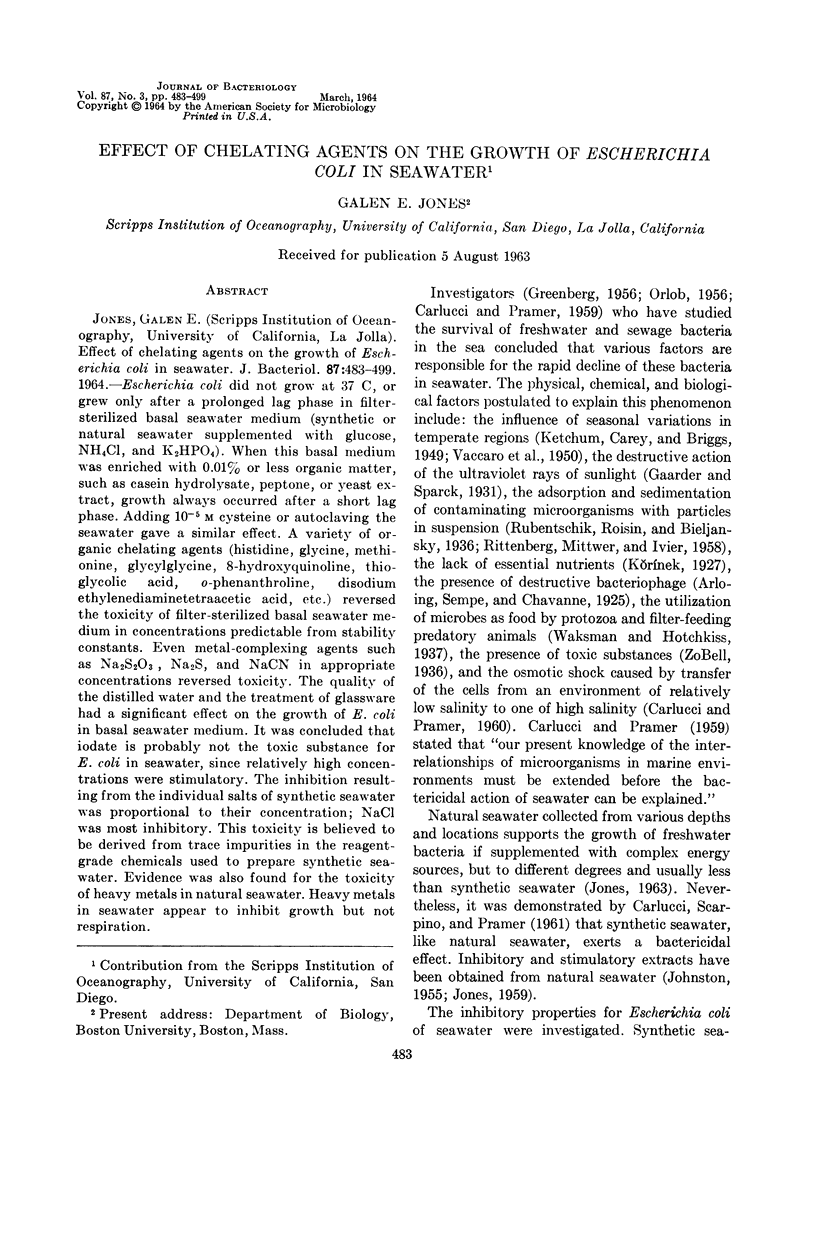
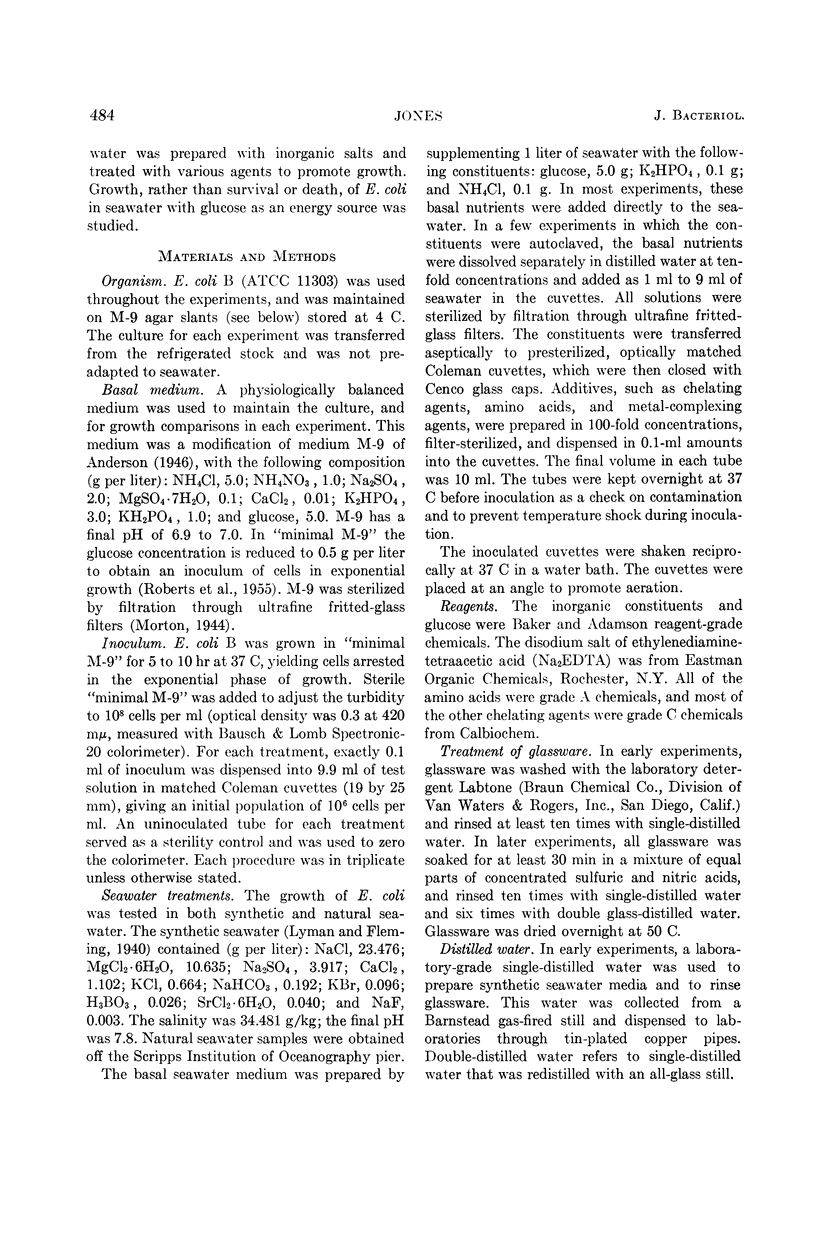
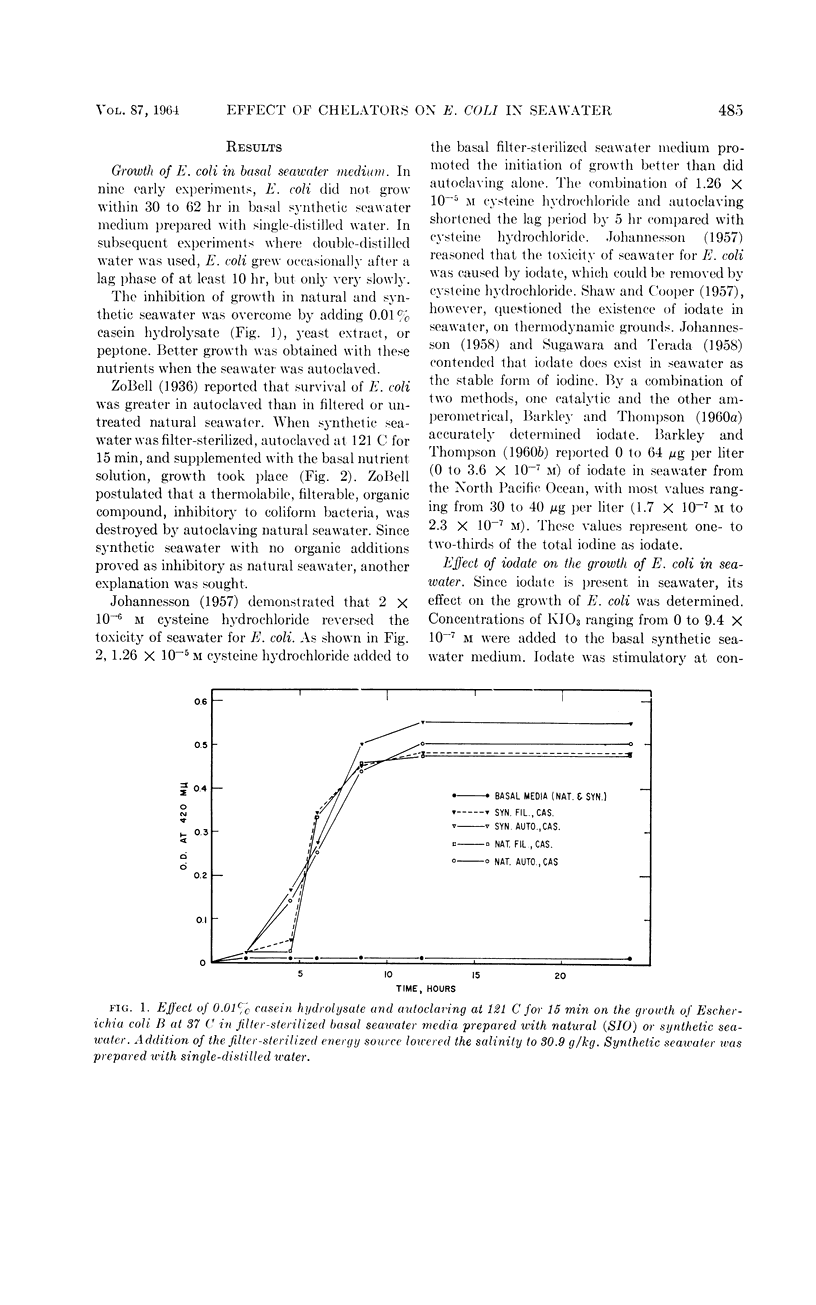
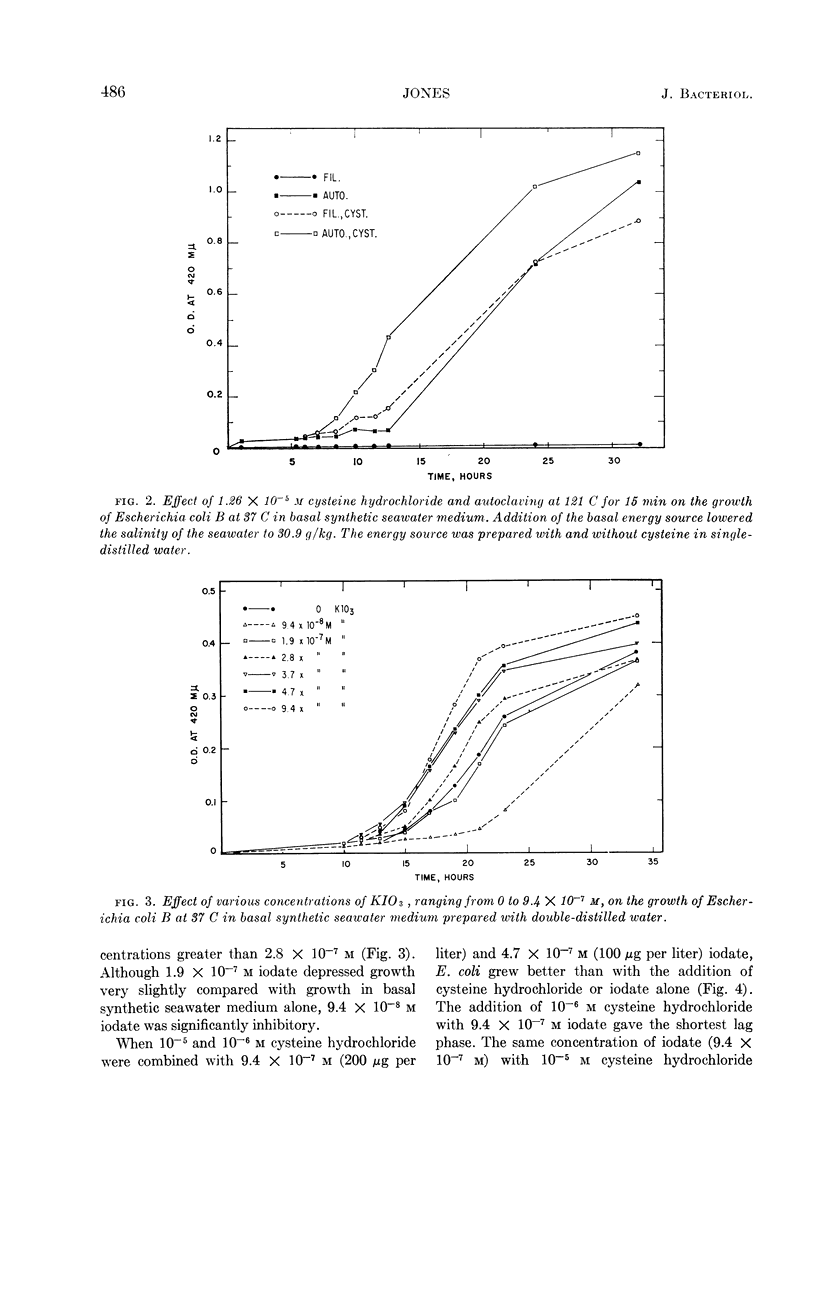
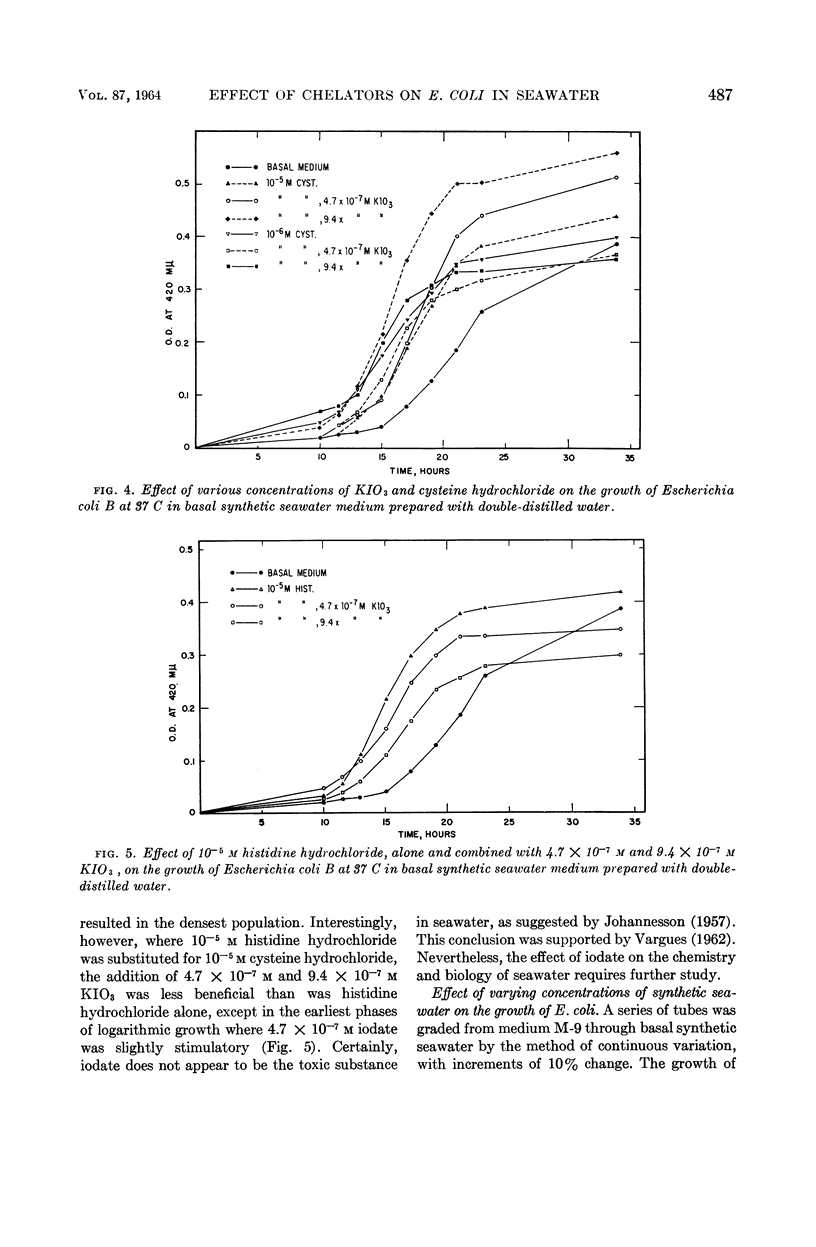
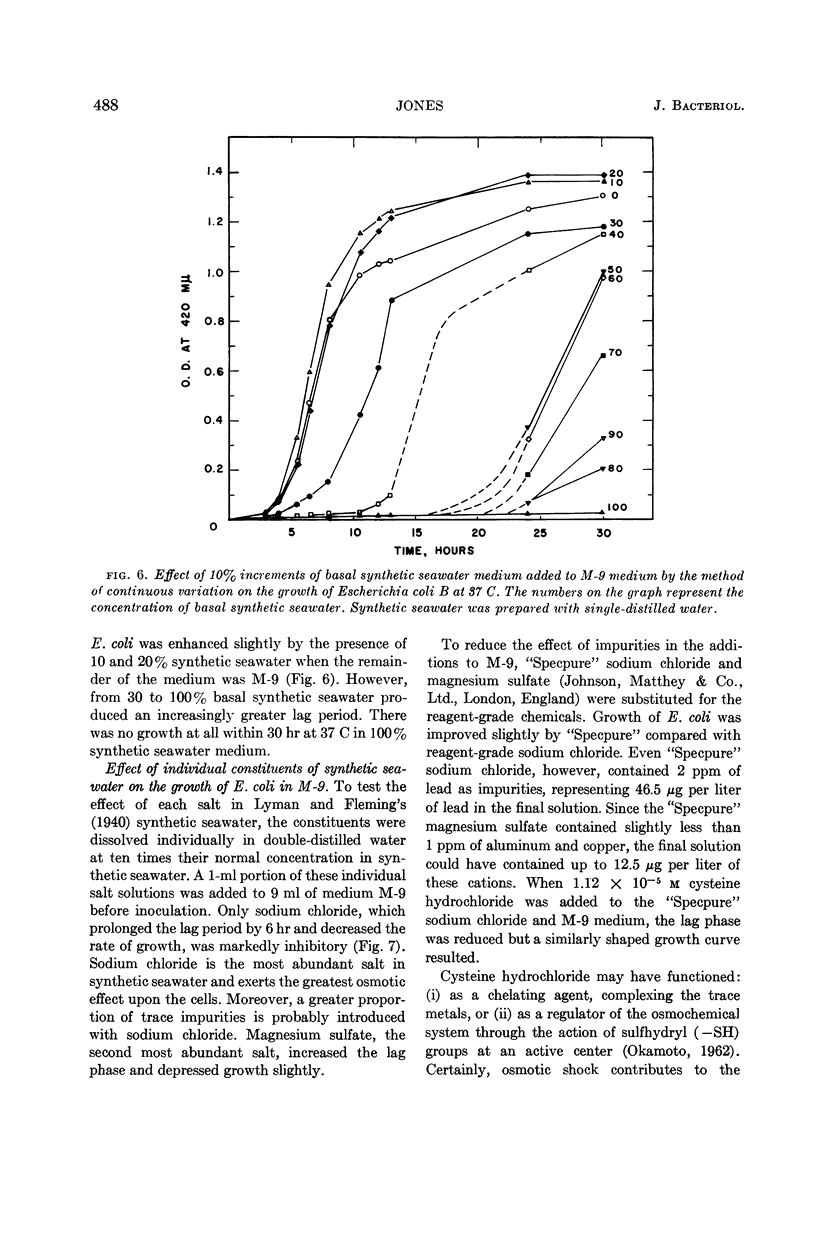
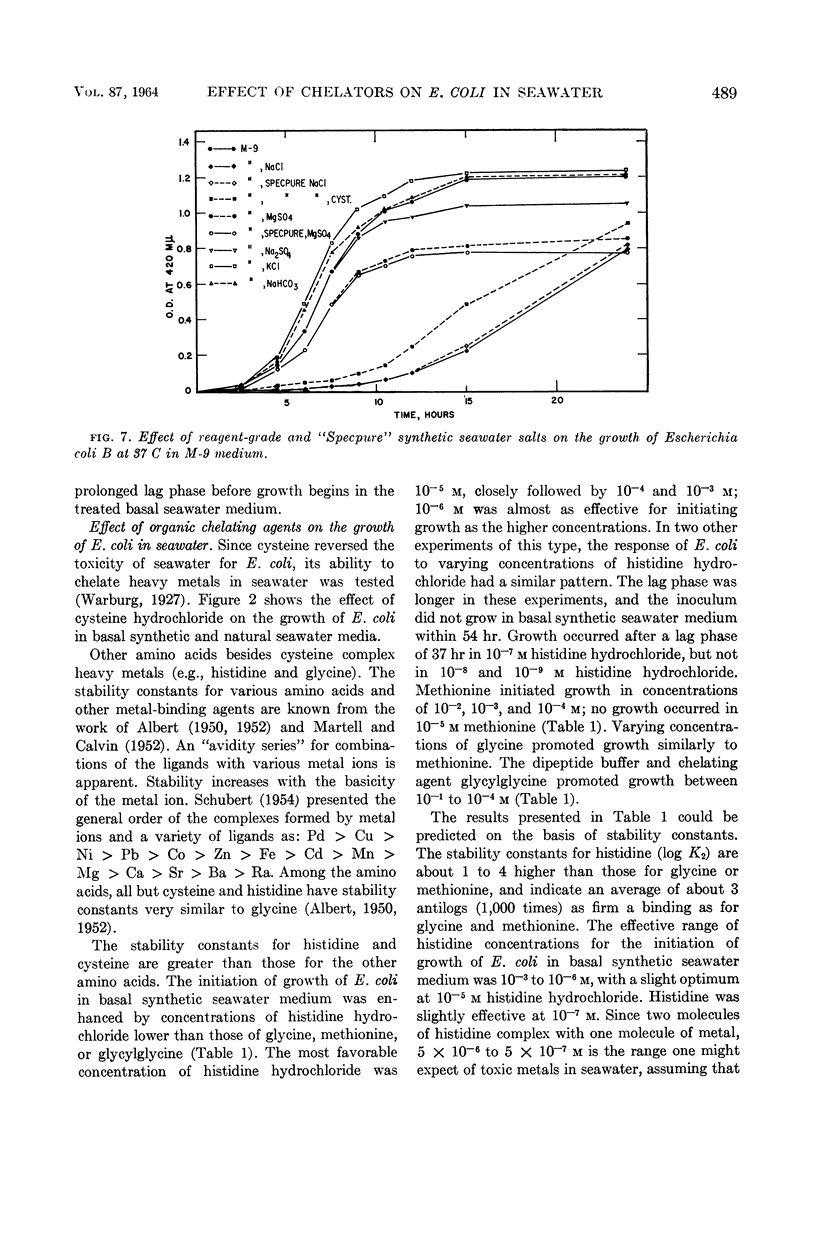
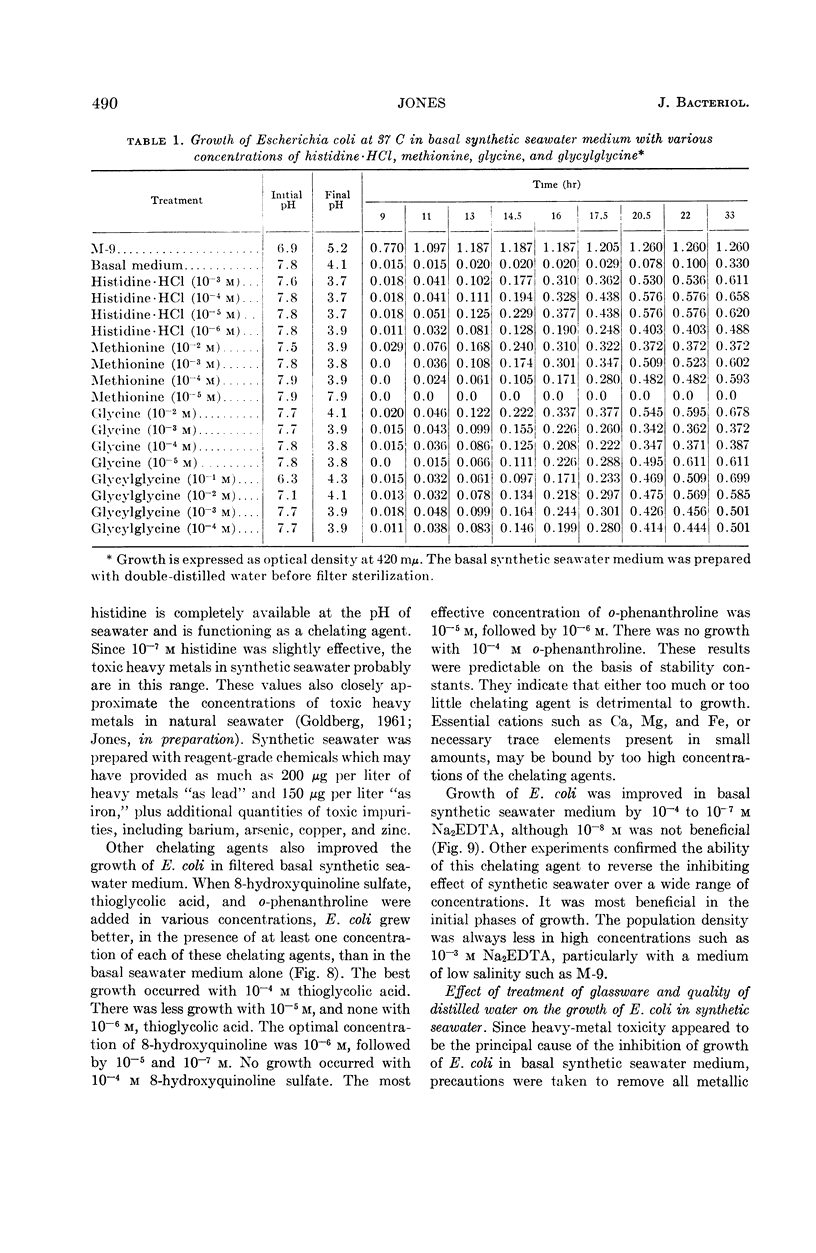
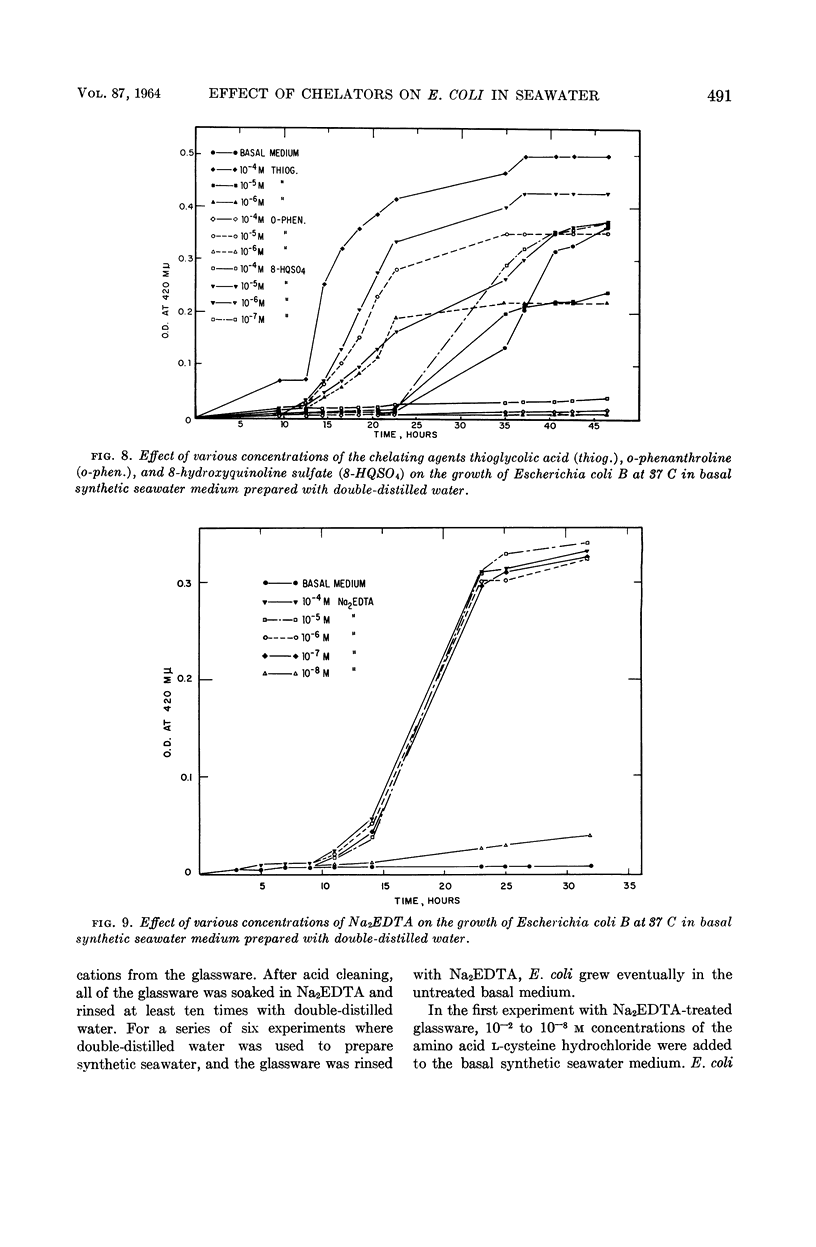
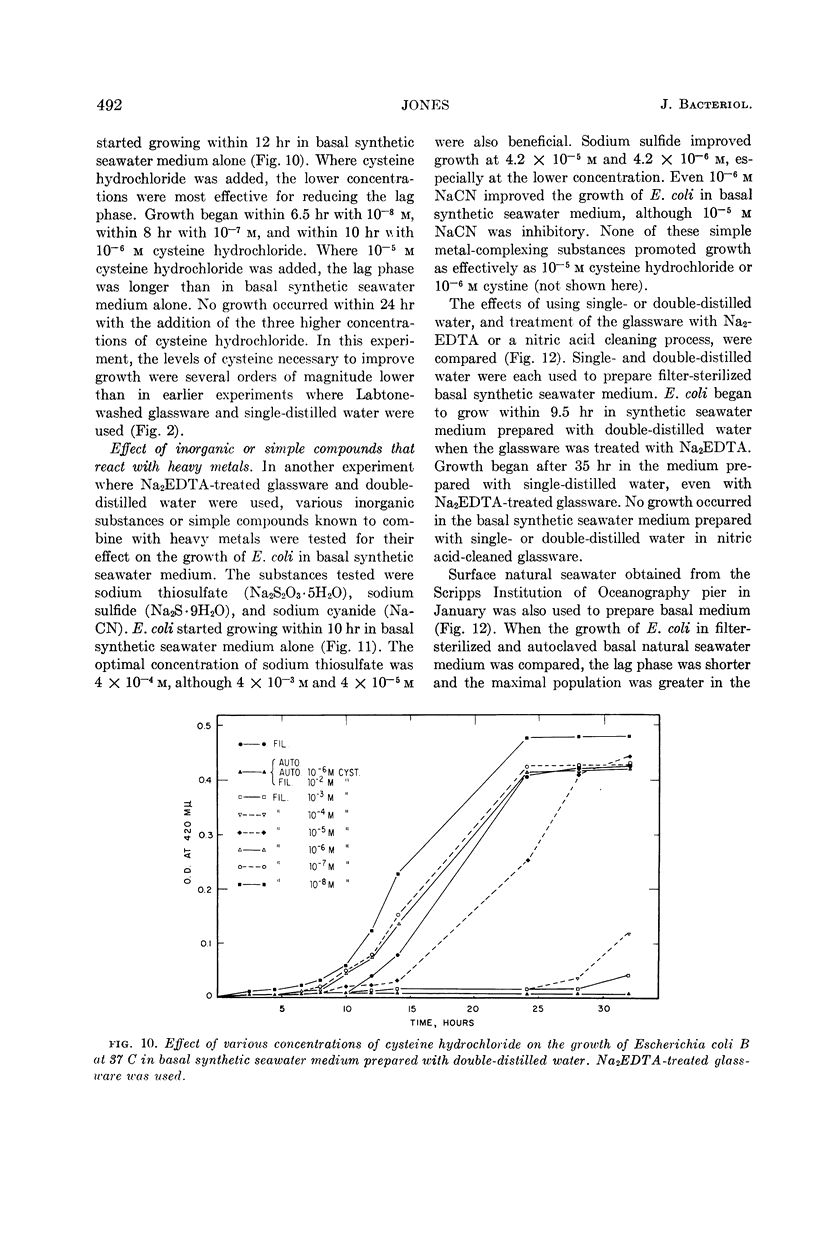
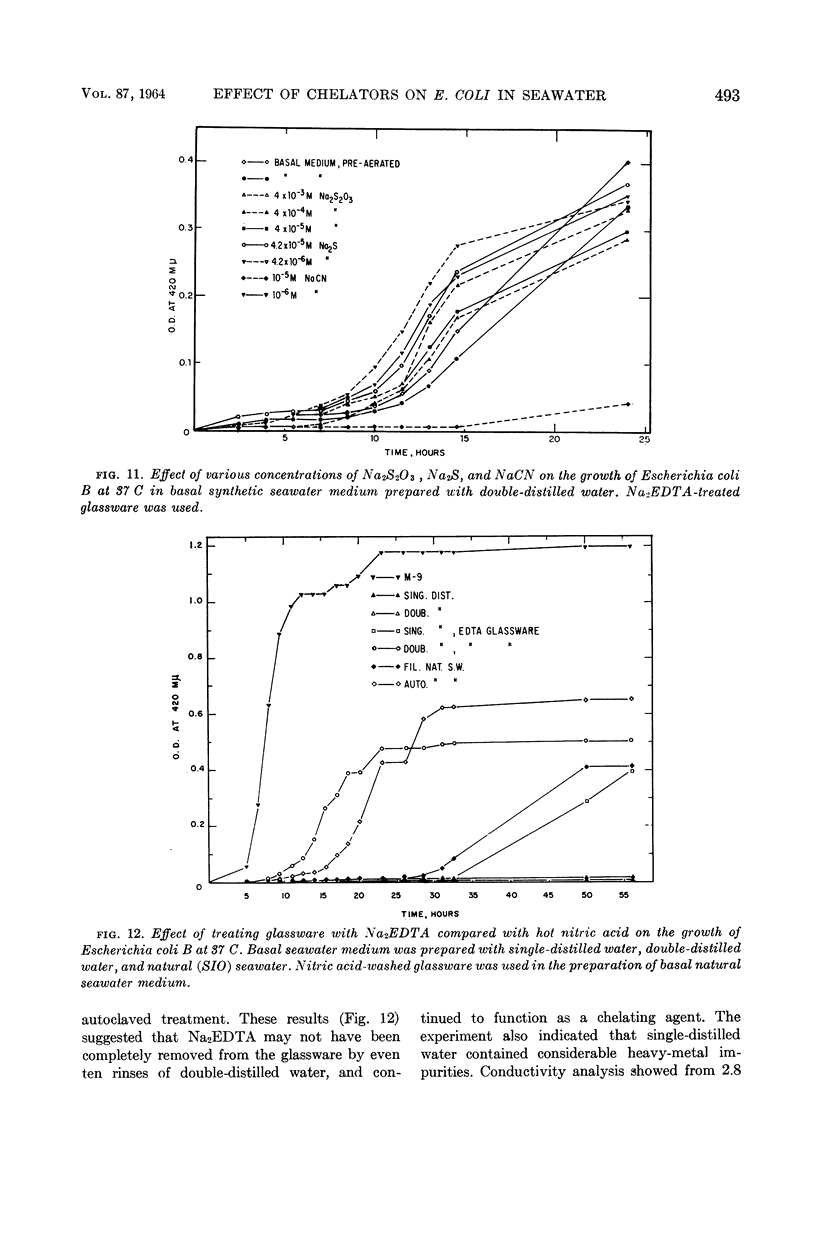
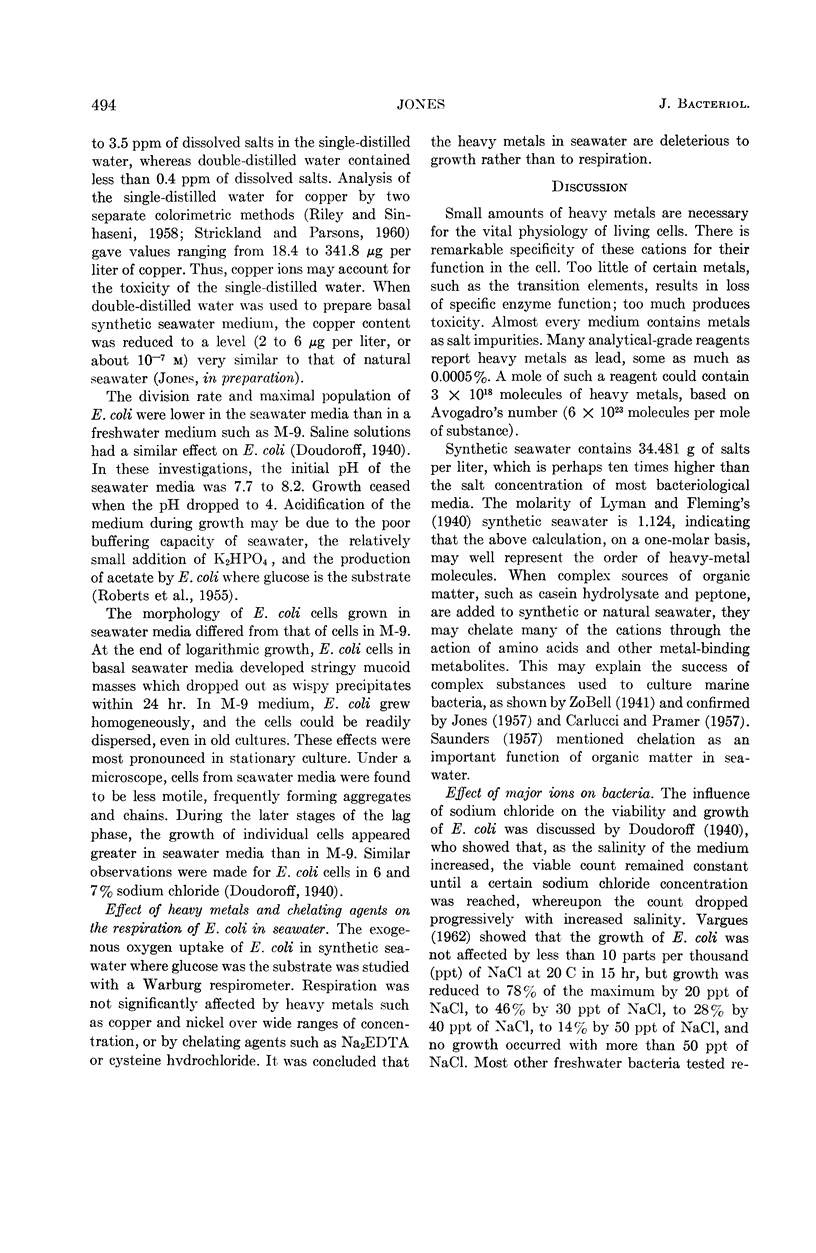
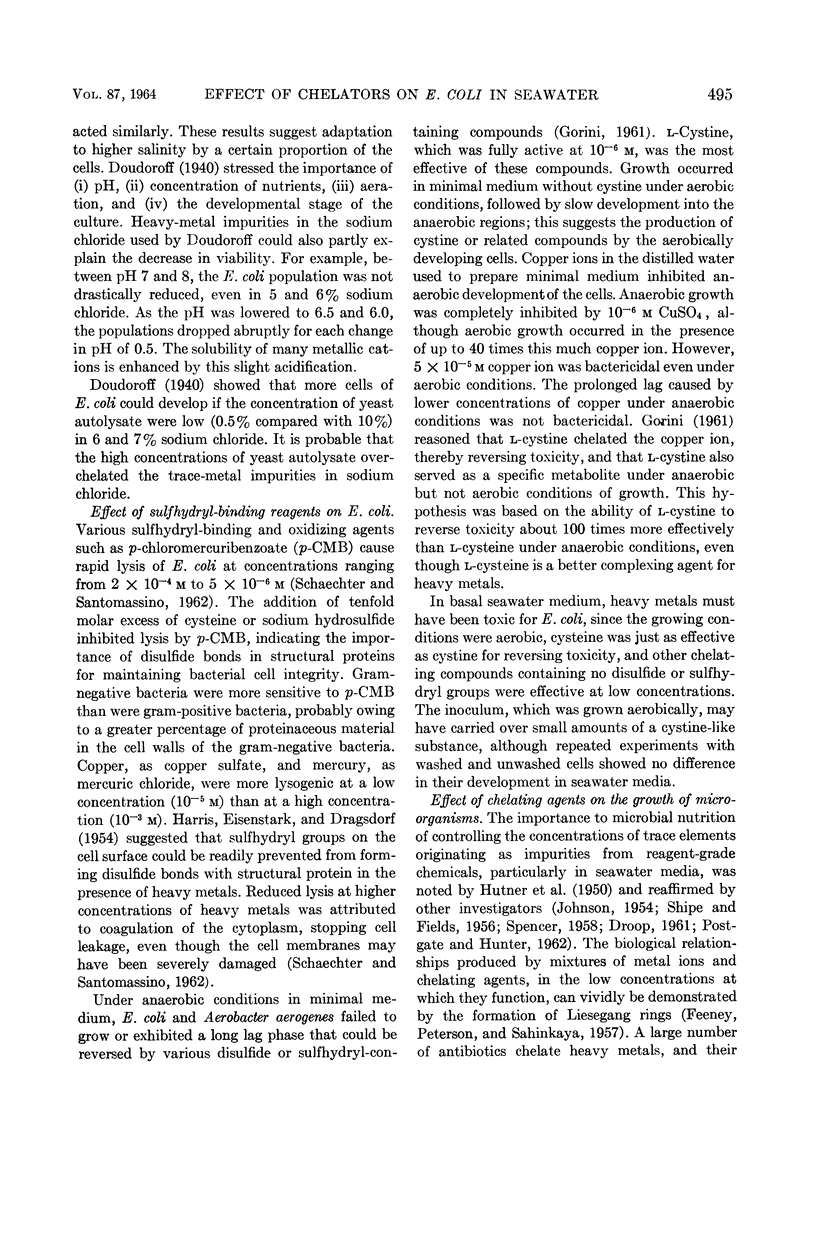
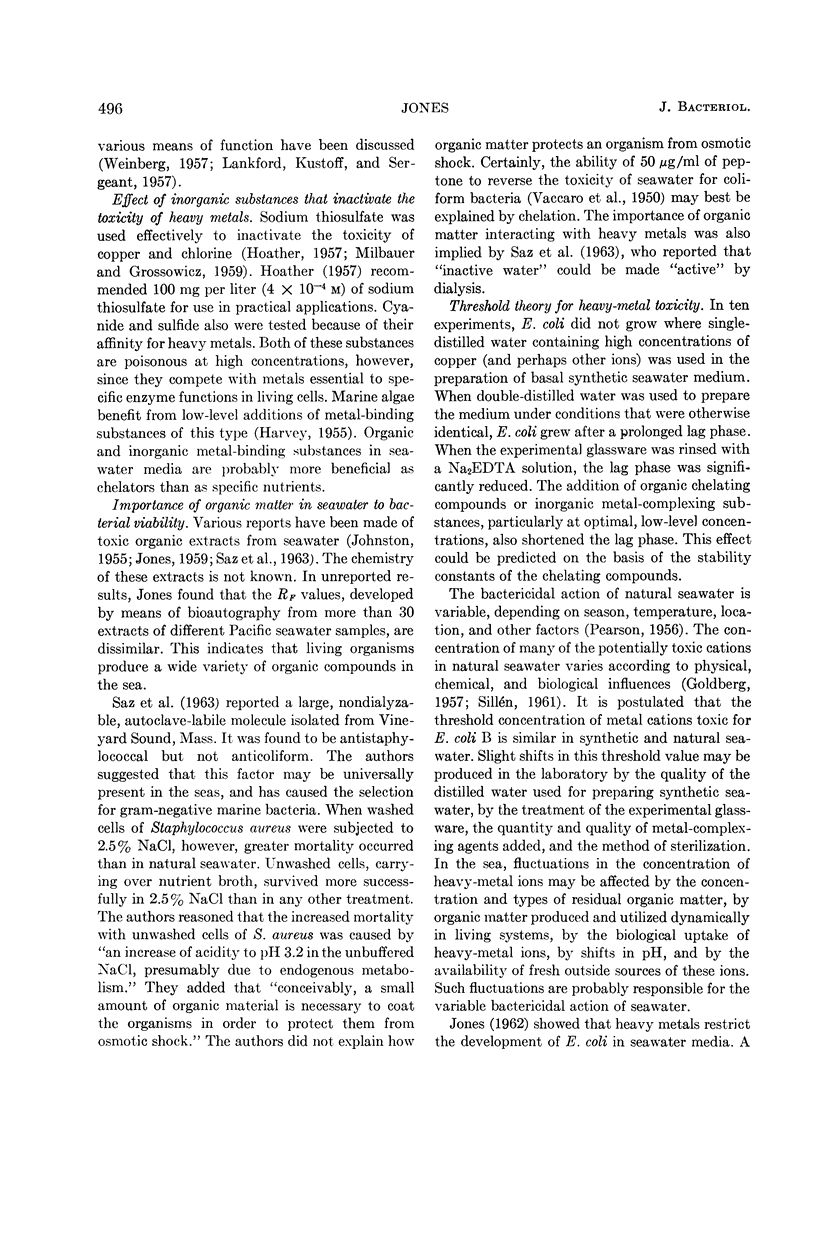
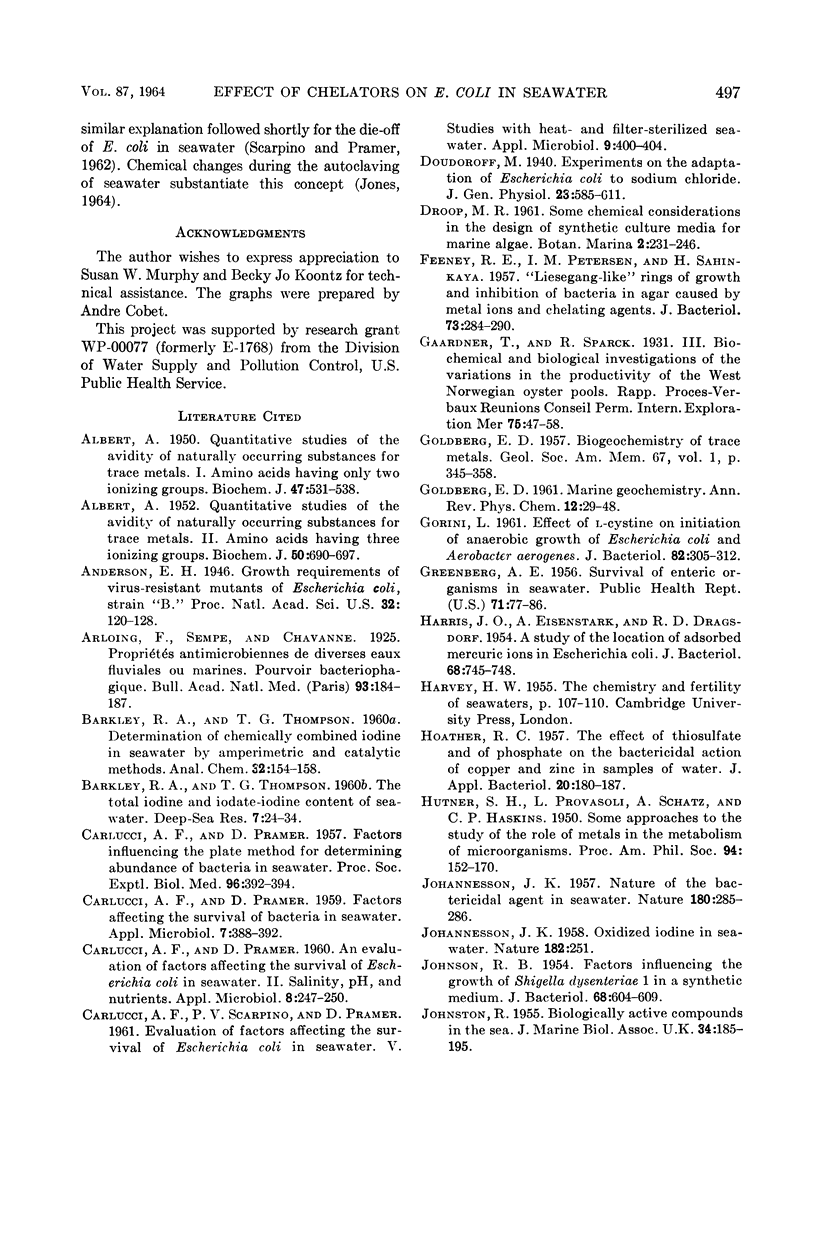
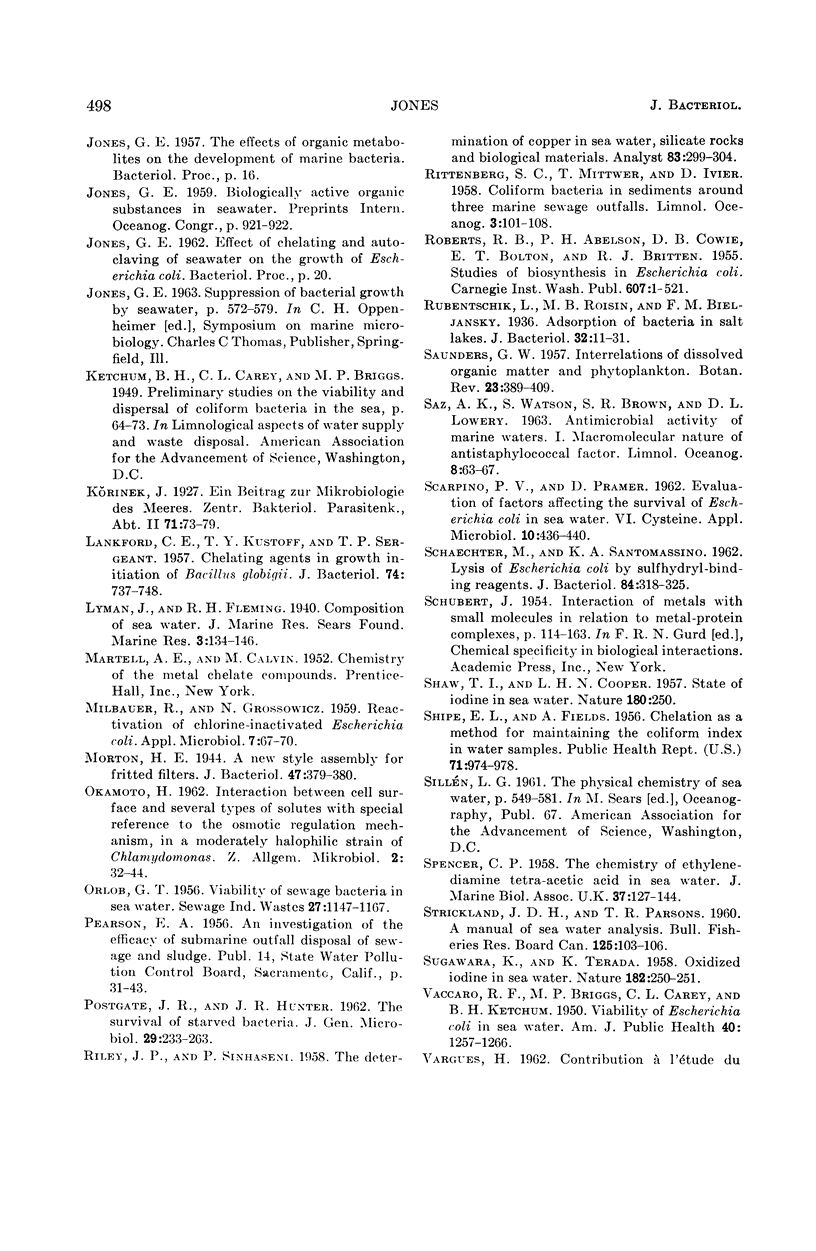
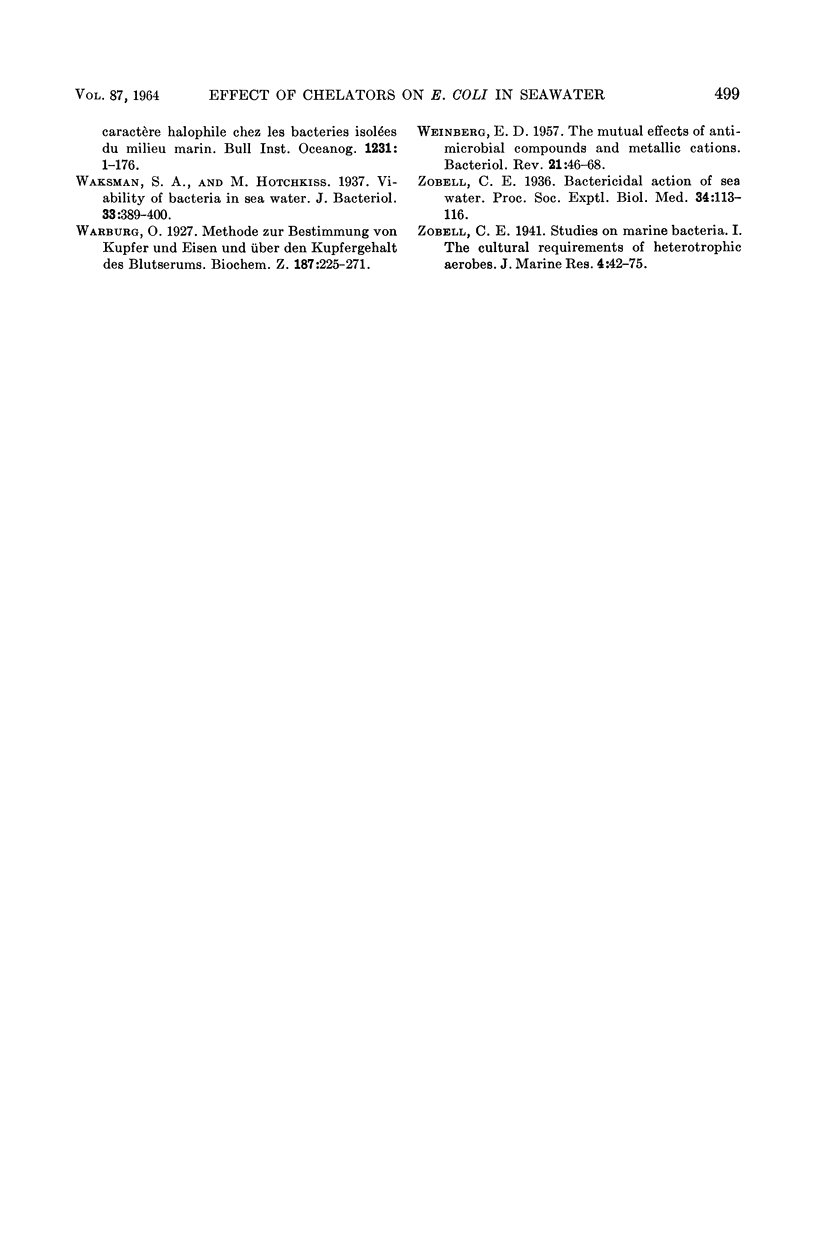
Selected References
These references are in PubMed. This may not be the complete list of references from this article.
- ALBERT A. Quantitative studies of the avidity of naturally occurring substances for trace metals. II. Amino-acids having three ionizing groups. Biochem J. 1952 Mar;50(5):690–697. doi: 10.1042/bj0500690. [DOI] [PMC free article] [PubMed] [Google Scholar]
- ALBERT A. Quantitative studies of the avidity of naturally occurring substances for trace metals; amino-acids having only two ionizing groups. Biochem J. 1950 Nov-Dec;47(5):531–538. doi: 10.1042/bj0470531. [DOI] [PMC free article] [PubMed] [Google Scholar]
- Anderson E. H. Growth Requirements of Virus-Resistant Mutants of Escherichia Coli Strain "B". Proc Natl Acad Sci U S A. 1946 May;32(5):120–128. doi: 10.1073/pnas.32.5.120. [DOI] [PMC free article] [PubMed] [Google Scholar]
- CARLUCCI A. F., PRAMER D. An evaluation of factors affecting the survival of Escherichia coli in sea water. II. Salinity, pH, and nutrients. Appl Microbiol. 1960 Jul;8:247–250. doi: 10.1128/am.8.4.247-250.1960. [DOI] [PMC free article] [PubMed] [Google Scholar]
- CARLUCCI A. F., PRAMER D. Factors affecting the survival of bacteria in sea water. Appl Microbiol. 1959 Nov;7:388–392. doi: 10.1128/am.7.6.388-392.1959. [DOI] [PMC free article] [PubMed] [Google Scholar]
- CARLUCCI A. F., PRAMER D. Factors influencing the plate method for determining abundance of bacteria in sea water. Proc Soc Exp Biol Med. 1957 Nov;96(2):392–394. doi: 10.3181/00379727-96-23487. [DOI] [PubMed] [Google Scholar]
- CARLUCCI A. F., SCARPINO P. V., PRAMER D. Evaluation of factors affecting survival of Escherichia coli in sea water. V. Studies with heat- and filter-sterilized sea water. Appl Microbiol. 1961 Sep;9:400–404. doi: 10.1128/am.9.5.400-404.1961. [DOI] [PMC free article] [PubMed] [Google Scholar]
- FEENEY R. E., PETERSEN I. M., SAHINKAYA H. Liesegang-like rings of growth and inhibition of bacteria in agar caused by metal ions and chelating agents. J Bacteriol. 1957 Feb;73(2):284–290. doi: 10.1128/jb.73.2.284-290.1957. [DOI] [PMC free article] [PubMed] [Google Scholar]
- FIELDS A., SHIPE E. L., Jr Chelation as a method for maintaining the coliform index in water samples. Public Health Rep. 1956 Oct;71(10):974–978. [PMC free article] [PubMed] [Google Scholar]
- GORINI L. Effect of L-cystine on initiation of anaerobic growth of Escherichia coli and Aerobacter aerogenes. J Bacteriol. 1961 Aug;82:305–312. doi: 10.1128/jb.82.2.305-312.1961. [DOI] [PMC free article] [PubMed] [Google Scholar]
- GREENBERG A. E. Survival of enteric organisms in sea water. Public Health Rep. 1956 Jan;71(1):77–86. [PMC free article] [PubMed] [Google Scholar]
- HARRIS J. O., EISENSTARK A., DRAGSDORF R. D. A study of the location of adsorbed mercuric ions in Escherichia coli. J Bacteriol. 1954 Dec;68(6):745–748. doi: 10.1128/jb.68.6.745-748.1954. [DOI] [PMC free article] [PubMed] [Google Scholar]
- JOHANNESSON J. K. Nature of the bactericidal agent in sea water. Nature. 1957 Aug 10;180(4580):285–286. doi: 10.1038/180285a0. [DOI] [PubMed] [Google Scholar]
- JOHNSON R. B. Factors influencing the growth of Shigella dysenterial in a synthetic medium. J Bacteriol. 1954 Nov;68(5):604–609. doi: 10.1128/jb.68.5.604-609.1954. [DOI] [PMC free article] [PubMed] [Google Scholar]
- LANKFORD C. E., KUSTOFF T. Y., SERGEANT T. P. Chelating agents in growth initiation of Bacillus globigii. J Bacteriol. 1957 Dec;74(6):737–748. doi: 10.1128/jb.74.6.737-748.1957. [DOI] [PMC free article] [PubMed] [Google Scholar]
- MILBAUER R., GROSSOWICZ N. Reactivation of chlorine-inactivated Escherichia coli. Appl Microbiol. 1959 Mar;7(2):67–70. doi: 10.1128/am.7.2.67-70.1959. [DOI] [PMC free article] [PubMed] [Google Scholar]
- Morton H. E. A New Style Assembly for Fritted Filters. J Bacteriol. 1944 Apr;47(4):379–380. doi: 10.1128/jb.47.4.379-380.1944. [DOI] [PMC free article] [PubMed] [Google Scholar]
- POSTGATE J. R., HUNTER J. R. The survival of starved bacteria. J Gen Microbiol. 1962 Oct;29:233–263. doi: 10.1099/00221287-29-2-233. [DOI] [PubMed] [Google Scholar]
- Rubentschik L., Roisin M. B., Bieljansky F. M. Adsorption of Bacteria in Salt Lakes. J Bacteriol. 1936 Jul;32(1):11–31. doi: 10.1128/jb.32.1.11-31.1936. [DOI] [PMC free article] [PubMed] [Google Scholar]
- SCARPINO P. V., PRAMER D. Evaluation of factors affecting the survival of Escherichia coli in sea water. VI. Cysteine. Appl Microbiol. 1962 Sep;10:436–440. doi: 10.1128/am.10.5.436-440.1962. [DOI] [PMC free article] [PubMed] [Google Scholar]
- SCHAECHTER M., SANTOMASSINO K. A. Lysis of Escherichia coli by sulfhydryl-binding reagents. J Bacteriol. 1962 Aug;84:318–325. doi: 10.1128/jb.84.2.318-325.1962. [DOI] [PMC free article] [PubMed] [Google Scholar]
- SHAW T. I., COOPER L. H. State of iodine in sea water. Nature. 1957 Aug 3;180(4579):250–250. doi: 10.1038/180250a0. [DOI] [PubMed] [Google Scholar]
- VACCARO R. F., BRIGGS M. P., CAREY C. L., KETCHUM B. H. Viability of Escherichia coli in sea water. Am J Public Health Nations Health. 1950 Oct;40(10):1257–1266. doi: 10.2105/ajph.40.10.1257. [DOI] [PMC free article] [PubMed] [Google Scholar]
- WEINBERG E. D. The mutual effects of antimicrobial compounds and metallic cations. Bacteriol Rev. 1957 Mar;21(1):46–68. doi: 10.1128/br.21.1.46-68.1957. [DOI] [PMC free article] [PubMed] [Google Scholar]
- Waksman S. A., Hotchkiss M. Viability of Bacteria in Sea Water. J Bacteriol. 1937 Apr;33(4):389–400. doi: 10.1128/jb.33.4.389-400.1937. [DOI] [PMC free article] [PubMed] [Google Scholar]


